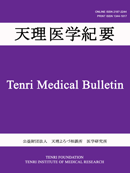Volume 22, Issue 1
Tenri Medical Bulletin
Displaying 1-8 of 8 articles from this issue
- |<
- <
- 1
- >
- >|
Special Article
-
Article type: oration
2019 Volume 22 Issue 1 Pages 1-11
Published: December 25, 2019
Released on J-STAGE: August 01, 2019
Download PDF (2821K)
Original Article
-
Article type: Original Article
2019 Volume 22 Issue 1 Pages 12-28
Published: December 25, 2019
Released on J-STAGE: August 01, 2019
Download PDF (4939K)
Case Report
-
Article type: case-report
2019 Volume 22 Issue 1 Pages 29-34
Published: December 25, 2019
Released on J-STAGE: August 01, 2019
Download PDF (1169K) -
Article type: case-report
2019 Volume 22 Issue 1 Pages 35-39
Published: December 25, 2019
Released on J-STAGE: August 01, 2019
Download PDF (956K)
Pictures at Bedside and Bench
-
Article type: Pictures at Bedside and Bench
2019 Volume 22 Issue 1 Pages 40-43
Published: December 25, 2019
Released on J-STAGE: August 01, 2019
Download PDF (1137K)
Awards (2018)
-
Article type: Awards (2018)
2019 Volume 22 Issue 1 Pages 46-47
Published: December 25, 2019
Released on J-STAGE: August 01, 2019
Download PDF (1380K) -
Article type: Awards (2018)
2019 Volume 22 Issue 1 Pages 48-49
Published: December 25, 2019
Released on J-STAGE: August 01, 2019
Download PDF (1034K) -
Article type: Awards (2018)
2019 Volume 22 Issue 1 Pages 50-53
Published: December 25, 2019
Released on J-STAGE: August 01, 2019
Download PDF (1683K)
- |<
- <
- 1
- >
- >|
